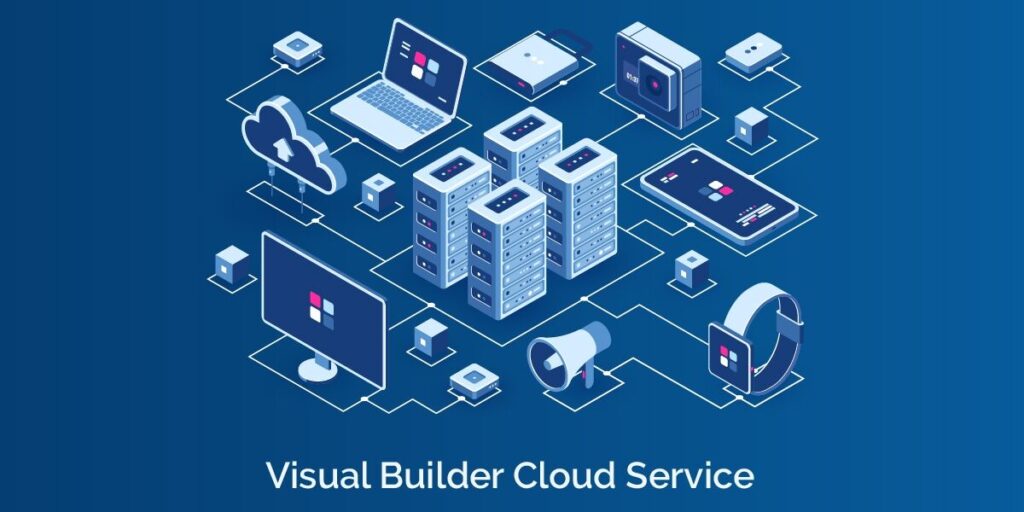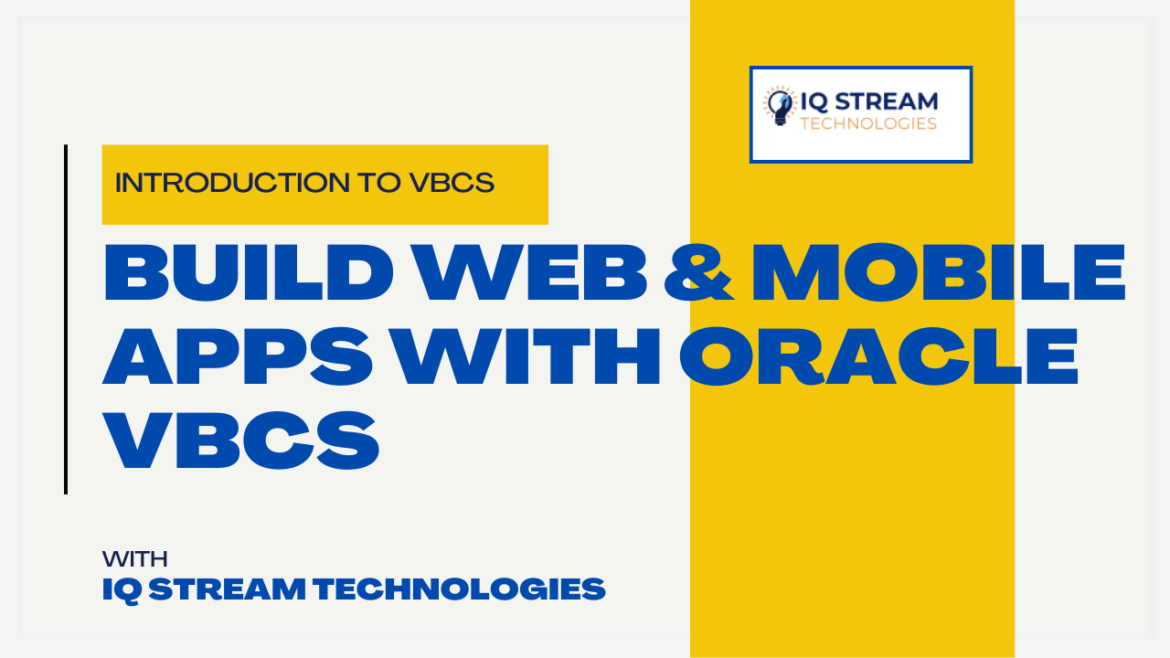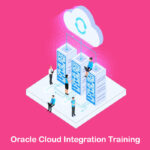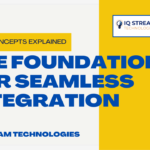Enterprise applications have become the backbone of modern businesses, streamlining operations, enhancing productivity, and improving customer experiences. However, developing these applications has traditionally been a complex, time-consuming, and resource-intensive process. This is where Oracle’s Visual Builder Cloud Service (VBCS) comes into play.
VBCS is a low-code, cloud-based development platform that enables organizations to build and deploy web and mobile applications quickly. It simplifies app development by offering a drag-and-drop UI, built-in integrations, and automation tools, reducing dependency on deep programming expertise.
This guide will take you through everything you need to know about Building Enterprise Apps with VBCS, from its key features and benefits to a step-by-step development guide, use cases, and best practices.
What is Oracle Visual Builder Cloud Service (VBCS)?
Oracle Visual Builder Cloud Service (VBCS) is a low-code, visual development platform that helps organizations design, develop, and deploy responsive web and mobile applications without extensive coding. It allows businesses to:
✅ Develop full-stack applications with a visual drag-and-drop interface.
✅ Integrate seamlessly with Oracle and third-party applications.
✅ Automate workflows with REST APIs and business rules.
✅ Deploy applications instantly on the cloud.
Key Capabilities of VBCS
| Feature | Description |
|---|---|
| Low-Code Development | Drag-and-drop interface for rapid app development. |
| Responsive UI | Automatically adjusts to desktops, tablets, and mobile devices. |
| Data Integration | Connects with REST APIs, Oracle applications, and external databases. |
| Automated Workflows | Allows business process automation using visual workflows. |
| Security Features | Built-in authentication, role-based access, and data encryption. |
Why Use Visual Builder Cloud Service for Enterprise Apps?
Enterprise applications require scalability, security, and integration capabilities—all of which VBCS offers.
🔹 Benefits of Using VBCS
1️⃣ Faster Development Time
With its drag-and-drop interface and pre-built components, VBCS significantly reduces development time compared to traditional coding methods.
2️⃣ Seamless Integration with Oracle Cloud Applications
VBCS provides out-of-the-box connectors for Oracle SaaS applications like ERP, HCM, and CX Cloud, ensuring seamless data flow across enterprise systems.
3️⃣ Cost-Effective & Low Maintenance
Being a cloud-native solution, VBCS eliminates the need for on-premise infrastructure, reducing IT maintenance costs.
4️⃣ Enhanced Collaboration & Flexibility
VBCS supports collaborative development, allowing multiple developers and business teams to work together on projects.
5️⃣ AI & Automation Support
VBCS integrates machine learning and AI to optimize workflows, enhance user experience, and improve data-driven decision-making.
How to Build Enterprise Apps Using VBCS?

Let’s walk through a step-by-step guide to building enterprise apps using Oracle Visual Builder Cloud Service.
🛠 Step 1: Set Up Your Development Environment
- Sign in to Oracle Cloud Console.
- Navigate to Visual Builder and create a new project.
- Choose between a Web App, Mobile App, or Progressive Web App (PWA).
📌 Step 2: Design the User Interface (UI)
VBCS offers drag-and-drop UI components, allowing you to create responsive, intuitive user interfaces quickly.
- Use pre-built templates for a professional design.
- Customize layouts using CSS, JavaScript, and Oracle JET components.
- Preview how your app will look on different devices.
📊 Example UI Design with VBCS
| UI Element | Description |
|---|---|
| Page Layouts | Drag-and-drop sections, grids, and forms. |
| Navigation Menus | Sidebars, dropdowns, and top navigations. |
| Forms & Inputs | User input fields, checkboxes, and buttons. |
🔗 Step 3: Connect to Data Sources
VBCS allows seamless integration with various data sources, including:
- Oracle SaaS applications (ERP, HCM, SCM).
- External APIs (Salesforce, SAP, REST APIs).
- Database connectivity (Oracle DB, MySQL, PostgreSQL).
📌 How to Connect Data in VBCS
- Create Data Objects – Define entities like “Customer,” “Orders,” “Invoices.”
- Bind UI Components to Data – Drag and drop fields like “Customer Name,” “Order Status.”
- Test Data Connectivity – Preview and ensure seamless real-time data flow.
⚙ Step 4: Implement Business Logic & Automation
VBCS allows low-code business rule implementation without requiring complex programming.
📌 Automation Features in VBCS
✅ Workflows – Automate approvals, notifications, and data processing.
✅ Triggers – Define actions like sending emails or updating databases.
✅ API Integration – Fetch real-time data from external applications.
🚀 Step 5: Deploy & Monitor Your Application
After development, VBCS provides one-click deployment for testing and production environments.
📌 Deployment Options
- Cloud Deployment: Instantly deploy on Oracle Cloud.
- On-Premise Deployment: Deploy using Oracle Cloud at Customer.
- Hybrid Deployment: Use both cloud and on-premise resources.
Real-time monitoring tools help track application performance, detect issues, and optimize user experience.
Use Cases of VBCS in Different Industries

📌 Retail & E-Commerce
- Inventory Management Apps – Track stock levels in real-time.
- Customer Order Tracking – Automate order fulfillment.
📌 Healthcare
- Patient Management Portals – Streamline hospital workflows.
- Telemedicine Apps – Enable remote consultations.
📌 Finance & Banking
- Loan Application Portals – Automate loan processing workflows.
- Fraud Detection Systems – Integrate AI-based fraud detection.
Common Challenges & Solutions in VBCS Development
| Challenge | Solution |
|---|---|
| UI Customization Limitations | Extend VBCS using JavaScript & CSS. |
| Performance Bottlenecks | Optimize API calls & enable caching. |
| Data Security Concerns | Use OAuth, token-based authentication, and encryption. |
FAQs on Building Enterprise Apps with VBCS
Q1: Is Oracle VBCS only for Oracle Cloud customers?
No, VBCS supports integration with third-party applications like Salesforce, SAP, and Microsoft Dynamics.
Q2: Can non-technical users build applications using VBCS?
Yes, VBCS is designed for both developers and business users with its low-code environment.
Q3: What types of applications can be built using VBCS?
Web applications, mobile applications, dashboards, and workflow automation apps.
Q4: Is VBCS suitable for large-scale enterprise applications?
Yes, VBCS supports enterprise-grade security, scalability, and automation for large organizations.
Q5: How does VBCS compare to other low-code platforms?
VBCS stands out due to its deep integration with Oracle Cloud, pre-built components, and enterprise-level security.
Conclusion
Oracle Visual Builder Cloud Service (VBCS) is a powerful low-code platform that accelerates enterprise application development. It enables businesses to build, deploy, and scale applications quickly while maintaining security and efficiency.
Whether you are a developer, business analyst, or IT manager, VBCS simplifies application development with its drag-and-drop interface, automated workflows, and real-time integrations.




